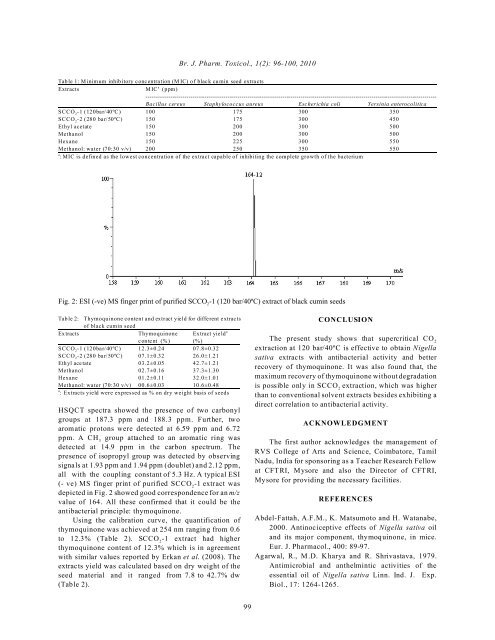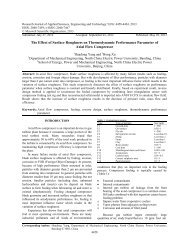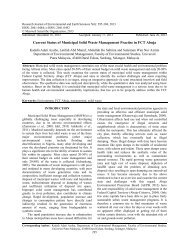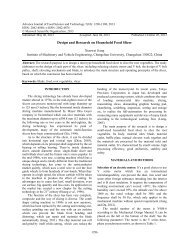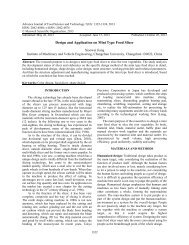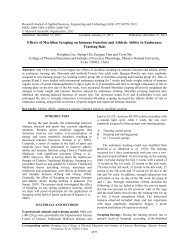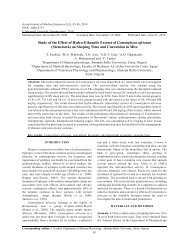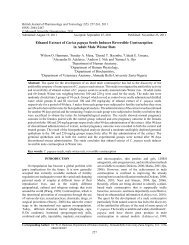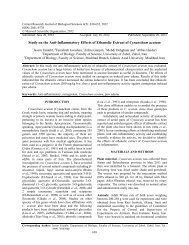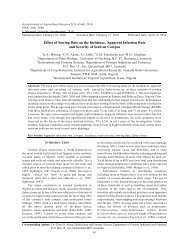Antibacterial Activity of Nigella sativa L. Seed ... - Maxwell Science
Antibacterial Activity of Nigella sativa L. Seed ... - Maxwell Science
Antibacterial Activity of Nigella sativa L. Seed ... - Maxwell Science
Create successful ePaper yourself
Turn your PDF publications into a flip-book with our unique Google optimized e-Paper software.
Br. J. Pharm. Toxicol., 1(2): 96-100, 2010<br />
Table 1: M inimum inhibitory concentration (M IC) <strong>of</strong> black cumin seed extracts<br />
Extracts MIC a (ppm)<br />
-----------------------------------------------------------------------------------------------------------------------------------------------<br />
Bacillus cereus Staphylococcus aureus Escherichia coli Yersinia enterocolitica<br />
SCCO 2 -1 (120bar/40ºC) 100 175 300 350<br />
SCCO 2-2 (280 bar/50ºC) 150 175 300 450<br />
Ethyl acetate 150 200 300 500<br />
Methanol 150 200 300 500<br />
Hexane 150 225 300 550<br />
Methanol: water (70:30 v/v) 200 250 350 550<br />
a : MIC is defined as the lowest concentration <strong>of</strong> the extract capable <strong>of</strong> inhibiting the complete growth <strong>of</strong> the bacterium<br />
Fig. 2: ESI (-ve) MS finger print <strong>of</strong> purified SCCO 2-1 (120 bar/40ºC) extract <strong>of</strong> black cumin seeds<br />
Table 2: Thymoquinone content and extract yield for different extracts<br />
<strong>of</strong> black cumin seed<br />
Extracts Thymoquinone Extract yield a<br />
content (%) (%)<br />
SCCO2-1 (120bar/40ºC) 12.3±0.24 07.8±0.32<br />
SCCO2-2 (280 bar/50ºC) 07.1±0.32 26.0±1.21<br />
Ethyl acetate 03.2±0.05 42.7±1.21<br />
Methanol 02.7±0.16 37.3±1.30<br />
Hexane 01.2±0.11 32.0±1.01<br />
Methanol: water (70:30 v/v) 00.6±0.03 10.6±0.48<br />
a<br />
: Extracts yield were expressed as % on dry weight basis <strong>of</strong> seeds<br />
HSQCT spectra showed the presence <strong>of</strong> two carbonyl<br />
groups at 187.3 ppm and 188.3 ppm. Further, two<br />
aromatic protons were detected at 6.59 ppm and 6.72<br />
ppm. A CH 3 group attached to an aromatic ring was<br />
detected at 14.9 ppm in the carbon spectrum. The<br />
presence <strong>of</strong> isopropyl group was detected by observing<br />
signals at 1.93 ppm and 1.94 ppm (doublet) and 2.12 ppm,<br />
all with the coupling constant <strong>of</strong> 5.3 Hz. A typical ESI<br />
(- ve) MS finger print <strong>of</strong> purified SCCO 2-1 extract was<br />
depicted in Fig. 2 showed good correspondence for an m/z<br />
value <strong>of</strong> 164. All these confirmed that it could be the<br />
antibacterial principle: thymoquinone.<br />
Using the calibration curve, the quantification <strong>of</strong><br />
thymoquinone was achieved at 254 nm ranging from 0.6<br />
to 12.3% (Table 2). SCCO 2-1 extract had higher<br />
thymoquinone content <strong>of</strong> 12.3% which is in agreement<br />
with similar values reported by Erkan et al. (2008). The<br />
extracts yield was calculated based on dry weight <strong>of</strong> the<br />
seed material and it ranged from 7.8 to 42.7% dw<br />
(Table 2).<br />
99<br />
CONCLUSION<br />
The present study shows that supercritical CO 2<br />
extraction at 120 bar/40ºC is effective to obtain <strong>Nigella</strong><br />
<strong>sativa</strong> extracts with antibacterial activity and better<br />
recovery <strong>of</strong> thymoquinone. It was also found that, the<br />
maximum recovery <strong>of</strong> thymoquinone without degradation<br />
is possible only in SCCO 2 extraction, which was higher<br />
than to conventional solvent extracts besides exhibiting a<br />
direct correlation to antibacterial activity.<br />
ACKNOWLEDGMENT<br />
The first author acknowledges the management <strong>of</strong><br />
RVS College <strong>of</strong> Arts and <strong>Science</strong>, Coimbatore, Tamil<br />
Nadu, India for sponsoring as a Teacher Research Fellow<br />
at CFTRI, Mysore and also the Director <strong>of</strong> CFTRI,<br />
Mysore for providing the necessary facilities.<br />
REFERENCES<br />
Abdel-Fattah, A.F.M., K. Matsumoto and H. Watanabe,<br />
2000. Antinociceptive effects <strong>of</strong> <strong>Nigella</strong> <strong>sativa</strong> oil<br />
and its major component, thymoquinone, in mice.<br />
Eur. J. Pharmacol., 400: 89-97.<br />
Agarwal, R., M.D. Kharya and R. Shrivastava, 1979.<br />
Antimicrobial and anthelmintic activities <strong>of</strong> the<br />
essential oil <strong>of</strong> <strong>Nigella</strong> <strong>sativa</strong> Linn. Ind. J. Exp.<br />
Biol., 17: 1264-1265.


